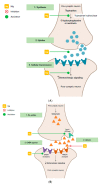Magnesium Status and Stress: The Vicious Circle Concept Revisited
- PMID: 33260549
- PMCID: PMC7761127
- DOI: 10.3390/nu12123672
Magnesium Status and Stress: The Vicious Circle Concept Revisited
Abstract
Magnesium deficiency and stress are both common conditions among the general population, which, over time, can increase the risk of health consequences. Numerous studies, both in pre-clinical and clinical settings, have investigated the interaction of magnesium with key mediators of the physiological stress response, and demonstrated that magnesium plays an inhibitory key role in the regulation and neurotransmission of the normal stress response. Furthermore, low magnesium status has been reported in several studies assessing nutritional aspects in subjects suffering from psychological stress or associated symptoms. This overlap in the results suggests that stress could increase magnesium loss, causing a deficiency; and in turn, magnesium deficiency could enhance the body's susceptibility to stress, resulting in a magnesium and stress vicious circle. This review revisits the magnesium and stress vicious circle concept, first introduced in the early 1990s, in light of recent available data.
Keywords: dietary intake; hypomagnesemia; magnesium; magnesium deficiency; magnesium supplementation; stress; vicious circle.
Conflict of interest statement
A.M. reports consultancy fees from Sanofi, unrelated to this publication. E.P. is an employee at Sanofi. G.P. has no conflicts of interest. L.N. is an employee at Sanofi. M.A. is an employee at Sanofi. M.T. has no conflicts of interest. P.B. reports speaker’s honoraria from: Abbott, Adamed, Angelini, Apotex, Astellas, Asteriamed, Bausch Health, BGP Products, BMS, Bioton, Boehringer Ingelheim, Bonnier Business, Chiesi, CROS, Fundacja Syntonia, Fundacja Zdrowie i Opieka, Gedeon Richter, + pharma, G-Pharma, Ipsen, Item Publishing, Janssen, Kimze, Krka, Lilly, Lundbeck, Medforum, Mediadore, Medical Education, Medical Experts, Medycyna Praktyczna, Mylan, Neoart, Novo Nordisk, P2P, Pfizer, Pierre Fabre, Polfa Tarchomin, Polpharma, Promed, QAH, Sandoz, Sanofi-Aventis, Servier, S & P Partners, Takeda, Termedia, Teva, Warsaw Voice, White Solutions, Valeant, Via Medica, VM Media, Zentiva. Y.N. has no conflicts of interest.
Figures



References
Publication types
MeSH terms
Substances
Grants and funding
LinkOut - more resources
Full Text Sources
Medical

